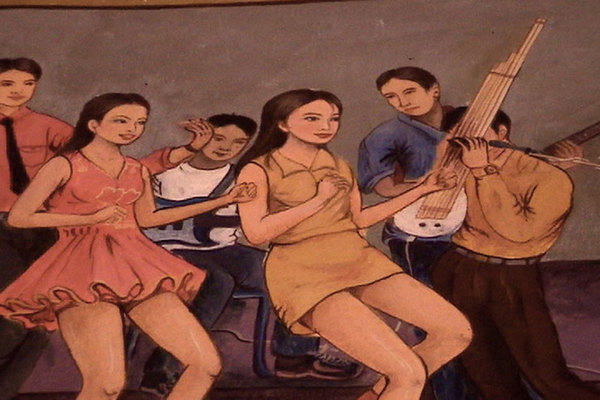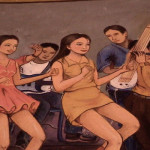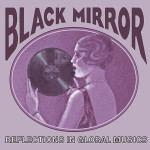SUBLIME FREQUENCIES SCREENING
Collecting and recreating a moment in time has been the crux of the recording industry since its inception. Though developed in the English speaking world, the technology was quickly deployed across the globe as the potential of foreign language markets began to be realized. This propagation had the side effect of allowing access to a much broader cultural landscape for everyone and of empowering the budding discipline of ethnomusicology. The technology’s spread brought a certain cultural validation, but did so with an increased risk for the creation of the exotic, cabinet-of-curiosities-type collections of voices and their equally marginalizing effect on the minority. Last Friday night, End of an Empire and Weirdo Records cosponsored a night of ethnographic film and music at Spectacle in Chinatown. The evening was divided into two complimentary presentations of collected foreign media. First were two Sublime Frequencies-produced films presented by the filmmaker Robert Millis. Sublime Frequencies, a record label, has grown up considerably from initial releases- often a mix of audio collages of radio scans, partial songs and unidentified foreign language speakers - to more recent discs that feature living, fully credited if often obscure artists. Both films fell within the scope and interest of the earlier releases on the label.
"My Friend Rain" is a musically-driven, psychedelic journey through southeast Asia during the rainy season. Visiting many of the most popular sites in the area, the film also lingered on some of the more subtle cultural markers of place, often highlighting unknown street musicians, food vendors who danced for themselves and the inundatory amounts of rain. While it was sometimes difficult to decipher the context of a particular scene, the enthralling power of the music and art was propulsive enough. Though it bared the distinct signs of hand-held video, the pacing invited the kind of blissful gazing that is needed for a performance of the Pat Waing or the image of tens of giant gold Buddha statues wrapped in cellophane.
Where "My Friend Rain" was a floating, easy trip that at times bordered on cultural tourism, "Phi Ta Khon: Ghosts of Isan" jumped right into the chaos of a little known, three-day buddhist festival in rural Thailand. The festival as depicted in this film is complete madness for the entire family, with beautiful and elaborate spirit masks, chaotic parades that seem to go where they please and plenty of rice whisky - all of which are punctuated by frantic, electrified Molam and Luk Thung music. The film brings us along for the ride as observers/tourists in the complex celebration that involves two days of exuberance with fierce animistic costumes and images which often veered into extremely violent and sexual territory, followed by one last day of subdued prayer.
Both films seemed at times to veer into the territory of exoticism, but did manage to portray a very complex cultural atmosphere, transposing joyful exuberance and beautiful artwork with inexplicably violent or sexual images. The music in each was exceptional, showing a keen eye for uniqueness and quality across styles and covering many instruments that are rare even in collections from that part of the world. Still, without any more than a cursory understanding of the politics and culture of southeast Asia much of the imagery was impenetrable, and I felt left alone to invent meaning. Though each film was driven in large part by the music, the lack of credits for any musician or songwriter also added to this sense of tourism.
By contrast, the second half of the evening featured a presentation of 78rpm records from the collection of Ian Nagoski. The setting was casual as Ian discussed the context of each selection, then played a recording from cd. The music was entirely international, much of it from his two proclaimed areas of interest: Indian classical music recorded around the fall of British colonialism and music of the ethnic minorities within the Ottoman empire immediately prior to its disintegration. Ian's descriptions were well researched and provided excellent background for some of these movements, and their musicians, that remain largely unknown in the west, but the music was the highlight. Beautiful and diverse, the selections brought us into the room with people and cultures who are long ago dead, though they did underscore the difficulty of holding an audience with prerecorded sound alone, as many of the screening’s 25 or so attendees had left by the halfway mark.
Viewed independently, these presentations took entirely different approaches to entirely different subjects, but taken as a whole they provided interesting connections and counterpoints within the ideas of multiculturalism and exoticism and showed that the world has always been a larger place than we know.
- Still image from Robert Millis’ My Friend Rain.
- Still image from Robert Millis’ Phi Ta Khon.
- The cover of Ian Nagoski’s compilation Black Mirror.
Phi Ta Khon Thailand Isan Morlam on Youtube.
The "Sublime Frequencies" screening took place on 19 June 2009 at Spectacle, 17 Edinboro Street #3 in Boston's Chinatown.
All images are courtesy of the artists.







